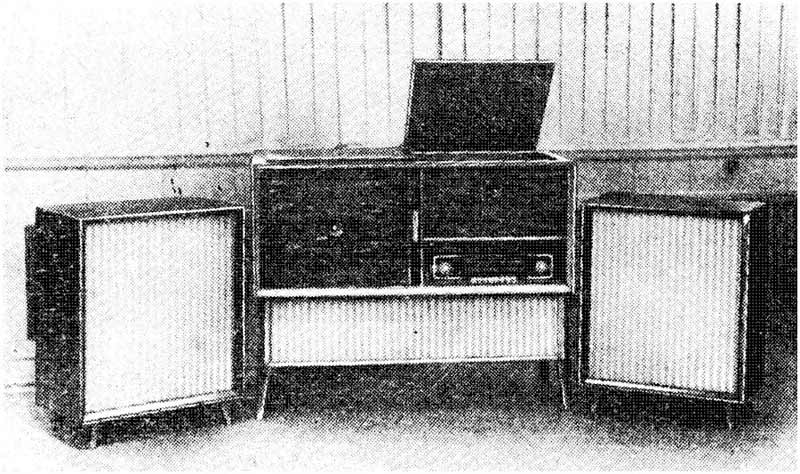Combined installation "Temp-9" (teleradiola).
Combined apparatus.The combined installation "Temp-9" (teleradiola) was experimentally produced in 1960 by the Moscow Radio Plant. The combined installation "Temp-9" consists of a TV set, a high-class radio receiver "Lux" and a tape recorder "Melody", adapted for playing stereo sound recording. In the upper part of the case, on the right, there is a cover, under which is a stereo tape recorder. On the left side of the case there is a TV set, on the right side there is a receiver. In front of the receiver and the TV screen there is a vertical moving protective board, which in the left position automatically turns off the TV, and in the right position turns off the receiver. The entire lower part of the case is occupied by an acoustic unit, two broadband bass amplifiers and rectifiers. Connecting the amplifier input to a TV, receiver or tape recorder, as well as turning on the rectifiers, are performed automatically when any of the TV and radio units is turned on using the appropriate relays. There is a chain of interlocks, which excludes the possibility of simultaneous operation of the TV and the receiver, and also ensures that the tape recorder is turned off when the top cover is lowered. On the left and right sides of the combination setup are two remote cases with speakers. When playing back stereo sound, these speakers are fed separately left and right channels, creating a stereo sound effect. During reception of the soundtrack of a TV program or reception of broadcasting stations, the general speaker of the TV and radio creates a surround sound effect. All the main control knobs for the receiver, TV and low frequency amplifier are located on the front side, and the control knobs for the tape recorder are located at the top. On the back side of the case, there are adjustment knobs that you rarely have to use. The Temp-4 TV works according to the superheterodyne circuit and has a high sensitivity. It uses a 53LK6B kinescope with an electron beam deflection angle of 110 °, with an aluminized screen. A 53LK2B kinescope with a beam deflection angle of 70 ° can also be used. The TV uses a delayed AGC and ARC, there is a knob for adjusting the clarity of the image. To ensure stable synchronization at weak signals, an inertial automatic line frequency control is introduced into the circuit. A special tuning indicator is used to fine-tune the TV during operation. Structurally, the TV is mounted on one chassis. The TV channel switch and kinescope are mounted on the walls of the case separately from the chassis. The TV set uses 18 vacuum tubes and 15 germanium diodes. The main technical data of the TV: Sensitivity on all channels 200 µV; horizontal clarity in the center of the screen 500 lines; vertical clarity in the center of the screen 550 lines. In the "Temp-9" installation, the LF part of the receiver is not used due to the fact that the TV and radio has a developed LF system with a powerful amplifier. The basic data of the Melody tape recorder does not differ in any way from the data of the basic model. It remains only to indicate some changes in the circuit and design of this tape recorder in this case. The tape recorder has a head for playing a stereo recording simultaneously from two tracks of the ferromagnetic treatment. To amplify the signals on the second channel, an additional three-stage amplifier was used on 2 6N2P tubes with independent power supply of the channel of the first 2 stages from a special rectifier. Gain control for 2 channels is carried out simultaneously with one common knob. When playing a stereo recording, the keys of the first and second tracks are pressed simultaneously, while two loop-through channels (left and right) work. It should be noted that a tape with a stereo recording is used only in one direction and to repeat the sound of the same program, you need to rewind the tape, therefore, the sounding time of a stereo recording is half the time of sounding a mono recording with a two-track system. Own bass amplifier of the tape recorder "Melody" is excluded. The bass amplifier has a push-pull output and is assembled according to an ultra-linear circuit, which gives the lowest nonlinear distortion. The outputs for LF and HF are separated and have independent transformers loaded on loudspeakers 10GD-18 and VGD-1, which are a remote unit for each amplifier and on loudspeakers 6GD-10 (2) and VG-D-1 (2) installed in the case. Tone control is carried out by smooth and fixed controls, corresponding to the cases of the most characteristic sound. Buttons located vertically between the TV set and the receiver "orchestra", "jazz", "bass", "solo", "speech" make it possible to choose a favorable sound. It should be noted that when the fixed tone is turned on, the smooth tone control remains on and can be used to adjust the tone. The tone control unit simultaneously makes the corresponding changes in the frequency characteristics of both bass amplifiers. The main technical data of the teleradiol: Operating frequency band 50 ... 12,000 Hz. The sound pressure developed by the unit is 25 bar. Nonlinear distortion factor: at midrange - 7%, high frequency - 5. The unit is powered from an alternating current network with a voltage of 110, 127 or 220 V. Power consumption from the network: when the TV is running 230 W; TV and tape recorder 300 W; receiver and tape recorder 230 W; receiver 150 W; tape recorder 180 watts.